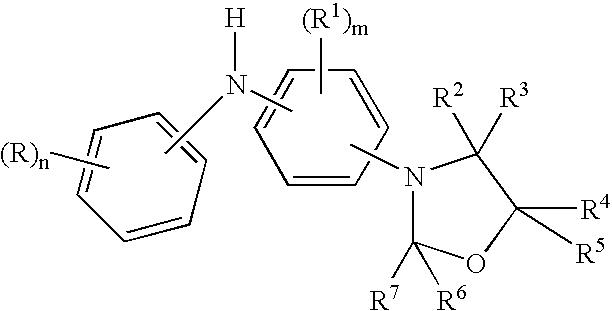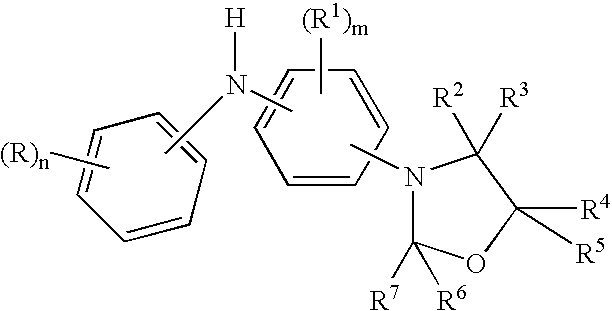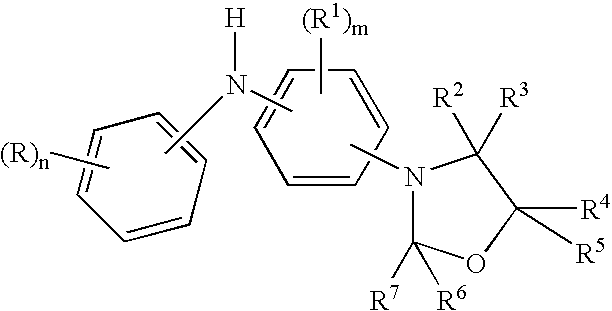Diaromatic amine derivatives as antioxidants
a technology of diaromatic amine and antioxidants, applied in the field of additives, can solve the problems of shortening limiting the service life of the catalytic converter that is used, and reducing the useful life so as to facilitate the long life and activity of the catalytic converter and high deposit protection
- Summary
- Abstract
- Description
- Claims
- Application Information
AI Technical Summary
Benefits of technology
Problems solved by technology
Method used
Image
Examples
example 1
Preparation of a mixture of 5-decyl-N-(N′-p-phenylanilino)-1,3-oxazolidine and 4-decyl-N-(N′-p-phenylanilino)-1,3-oxazolidine
[0060] Into a 250 ml reaction flask was charged 60 g (0.32 mol) of p-N-phenylphenylenediamine, 62 g (0.32 mol) of 1,2-epoxydodecane, 75 ml of cyclohexane and 6.0 g of an acid clay catalyst. The reaction mixture was stirred under a blanketed with argon and heated to 75° C. These reaction conditions were maintained for 4 hours. The reaction temperature was then lowered to 50° C. and the reaction mixture was filtered to remove the clay catalyst. The hot filtered reaction material was transferred to a 500 ml reaction flask equipped with a Deans-Stark water trap. The reaction media was stirred under argon blanket and heated to 60° C. followed by the 2.5 hour addition of 28 g (0.35 mol) of 37% formalin. After the formalin addition was complete, the temperature was maintained at 60° C. for one hour before raising the temperature to reflux to remove water to the Dean...
example 2
Preparation of a mixture of 5-dodecyl-N-(N′-p-phenylanilino)-1,3-oxazolidine and 4-dodecyl-N-(N′-p-phenylanilino)-1,3-oxazolidine
[0061] Into a 100 ml reaction flask was charged 18.6 g(0.1 mol) of p-N-phenylphenylenediamine, 27.5 g (0.11 mol) of 1,2-epoxytetradecane, 25 ml of cyclohexane and 3.0 g of an acid clay catalyst. The reaction mixture was stirred under a blanketed with argon and heated to 75° C. These reaction conditions were maintained for 4 hours. The reaction temperature was then lowered to 60° C. and the reaction mixture was filtered to remove the clay catalyst. The hot filtered reaction material was transferred to a 100 ml reaction flask equipped with a Deans-Stark water trap. The reaction media was stirred under argon blanket and heated to 60° C. followed by the 1.5 hour addition of 10 g (0.12 mol) of 37% formalin. After the formalin addition was complete, the temperature was maintained at 60° C. for one hour before raising the temperature to reflux to remove water to...
example 3
Preparation of a mixture of 5-(2-ethylhexyl)oxymethylene-N-(N′-p-phenylanilino)-1,3-oxazolidine and 4-(2-ethylhexyl)oxymethylene-N-(N′-p-phenylanilino)-1,3-oxazolidine
[0062] Into a 100 ml reaction flask was charged 18.6 g(0.1 mol) of p-N-phenylphenylenediamine, 19.5 g (0.11 mol) of 2-ethylhexyl glycidol ether, 25 ml of cyclohexane and 3.0 g of an acid clay catalyst. The reaction mixture was stirred under a blanketed with argon and heated to 75° C. These reaction conditions were maintained for 3 hours. The reaction temperature was then lowered to 60° C. and the reaction mixture was filtered to remove the clay catalyst. The hot filtered reaction material was transferred to a 100 ml reaction flask equipped with a Deans-Stark water trap. The reaction media was stirred under argon blanket and heated to 60° C. followed by the 1.5 hour addition of 9.0 g (0.11 mol) of 37% formalin. After the formalin addition was complete, the temperature was maintained at 60° C. for one hour before raisin...
PUM
| Property | Measurement | Unit |
|---|---|---|
| temperature | aaaaa | aaaaa |
| temperature | aaaaa | aaaaa |
| temperature | aaaaa | aaaaa |
Abstract
Description
Claims
Application Information
 Login to View More
Login to View More - R&D
- Intellectual Property
- Life Sciences
- Materials
- Tech Scout
- Unparalleled Data Quality
- Higher Quality Content
- 60% Fewer Hallucinations
Browse by: Latest US Patents, China's latest patents, Technical Efficacy Thesaurus, Application Domain, Technology Topic, Popular Technical Reports.
© 2025 PatSnap. All rights reserved.Legal|Privacy policy|Modern Slavery Act Transparency Statement|Sitemap|About US| Contact US: help@patsnap.com



